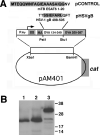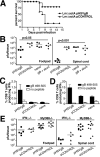Cutting edge: recombinant Listeria monocytogenes expressing a single immune-dominant peptide confers protective immunity to herpes simplex virus-1 infection
- PMID: 17404252
- PMCID: PMC2626165
- DOI: 10.4049/jimmunol.178.8.4731
Cutting edge: recombinant Listeria monocytogenes expressing a single immune-dominant peptide confers protective immunity to herpes simplex virus-1 infection
Abstract
The vast majority of the world's population is infected with HSV. Although antiviral therapy can reduce the incidence of reactivation and asymptomatic viral shedding, and limit morbidity and mortality from active disease, it cannot cure infection. Therefore, the development of an effective vaccine is an important global health priority. In this study, we demonstrate that recombinant Listeria monocytogenes (Lm) expressing the H-2K(b) glycoprotein B (gB)(498-505) peptide from HSV-1 triggers a robust CD8 T cell response to this Ag resulting in protective immunity to HSV infection. Following challenge with HSV-1, immune-competent mice primed with recombinant Lm-expressing gB(498-505) Ag were protected from HSV-induced paralysis. Protection was associated with dramatic reductions in recoverable virus, and early expansion of HSV-1-specific CD8 T cells in the regional lymph nodes. Thus, recombinant Lm-expressing Ag from HSV represents a promising new class of vaccines against HSV infection.
Figures



References
-
- Smith JS, Robinson NJ. Age-specific prevalence of infection with herpes simplex virus types 2 and 1: a global review. J Infect Dis. 2002;186(Suppl 1):S3–28. - PubMed
-
- Kimberlin D. Herpes simplex virus, meningitis and encephalitis in neonates. Herpes. 2004;11(Suppl 2):65A–76A. - PubMed
-
- Kimberlin DW, Lin CY, Jacobs RF, Powell DA, Corey L, Gruber WC, Rathore M, Bradley JS, Diaz PS, Kumar M, Arvin AM, Gutierrez K, Shelton M, Weiner LB, Sleasman JW, de Sierra TM, Weller S, Soong SJ, Kiell J, Lakeman FD, Whitley RJ. Safety and efficacy of high-dose intravenous acyclovir in the management of neonatal herpes simplex virus infections. Pediatrics. 2001;108:230–238. - PubMed
-
- Danve-Szatanek C, Aymard M, Thouvenot D, Morfin F, Agius G, Bertin I, Billaudel S, Chanzy B, Coste-Burel M, Finkielsztejn L, Fleury H, Hadou T, Henquell C, Lafeuille H, Lafon ME, Le Faou A, Legrand MC, Maille L, Mengelle C, Morand P, Morinet F, Nicand E, Omar S, Picard B, Pozzetto B, Puel J, Raoult D, Scieux C, Segondy M, Seigneurin JM, Teyssou R, Zandotti C. Surveillance network for herpes simplex virus resistance to antiviral drugs: 3-year follow-up. J Clin Microbiol. 2004;42:242–249. - PMC - PubMed
-
- Stranska R, Schuurman R, Nienhuis E, Goedegebuure IW, Polman M, Weel JF, Wertheim-Van Dillen PM, Berkhout RJ, van Loon AM. Survey of acyclovir-resistant herpes simplex virus in the Netherlands: prevalence and characterization. J Clin Virol. 2005;32:7–18. - PubMed
Publication types
MeSH terms
Substances
Grants and funding
LinkOut - more resources
Full Text Sources
Other Literature Sources
Research Materials

